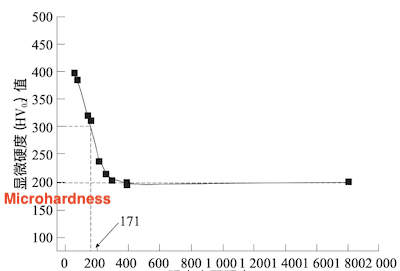2. Test results
According to the industry standard DL/T 1603-2016 "Technical Conditions for Quality Inspection and Acceptance of Shot Blasting Layer on the Inner Wall of Austenitic Stainless Steel Boiler Tubes", the Vickers microhardness tester is used to inspect according to the national standard GB/T 4340.1; the test load is 1.96N, and the loading time is 10 to 15 seconds. Inspection positions and number of measuring points: 4 inspection positions at 3 o'clock, 6 o'clock, 9 o'clock and 12 o'clock (angles of 0°, 90°, 180° and 270°) are drawn randomly on the transverse ring sample. The shot blasting layer is tested at a distance of 60μm from the surface of the inner wall, and at least three microhardness values are measured at each detection position; the average value is taken as the hardness value at this position; the microhardness test is performed at half the wall thickness of the base metal. At least 3 values are measured and take the average value.
Table 2 Statistical data of shot blasting hardness tests
According to the test results, process parameters such as working pressure, spray gun feeding speeds, projectile flow rates, and shot blasting times all have an impact on the increase in the microhardness of the shot blasting layer. Analyzed item by item, the impact of shot flow and number of shots is the most significant. The impact of spray gun working pressure is small; the impact of spray gun feeding speed is less obvious. Comparing the shot blasting effect of samples under different process parameters, the 3-2 and 4-2 samples have the best effect. In the case of other parameters being the same, the 4-2 sample was shot blasted three times, which had a certain influence on the production efficiency. Use the metallographic method to detect the effective shot blasting layer depth of 3-2 sample, and the results are shown in Figure 5; use the microhardness curve method to detect the effective shot blasting layer depth of 3-2 sample, and the sampling position and results are shown in Figures 6, 7 and table 3.

Figure 5 Metallographic methods to measure the depth of shot blasting layers
According to the industry standard DL/T 1603-2016 "Technical Conditions for Quality Inspection and Acceptance of Shot blasting Layer on the Inner Wall of Austenitic Stainless Steel Boiler Tubes", the requirements for the performance of the shot blasting layer inside the austenitic stainless steel
boiler tube are that the depth of the shot blasting layer of the effective spraying layer measured by the metallographic method is not less than 70μm; the effective depth of the shot blasting layer measured by the hardness curve method is not less than 60μm; at the depth of 60μm from the inner wall surface of the same cross section of the shot blasting tube, the increased value of the hardness value (HV) measured at along the direction at 3 o'clock, 6 o'clock, and 9 o'clock should not be less than 100, and the difference between the values should not be greater than 50. For S30432 steel pipes, the hardness at 60μm of the shot blasting layer shall not be less than 280.

Figure 6 Sampling positions for microhardness inspection of shot blasting layer of a single sample (×200)

Figure 7 Microhardness test results of the shot blasting layer of a single sample
From the above, it can be obtained that the effective shot blasting layer depth of the 3-2 sample is 176μm (metallographic methods)/171μm (microhardness methods), and the hardness at 60μm of the shot blasting layer reaches 364; the shot blasting effect is good. The test results better meet the standard requirements.
5.
Analysis and conclusion
Through the above comparative tests and analysis, the following conclusions can be come for the internal shot blasting of S30432 austenitic stainless steel boiler tubes:
1) Process parameters such as working pressure, spray gun feeding speeds, projectile flow rates, and shot blasting times all have an impact on the microhardness increase in the shot blasting layer, among which the impact of shot flow rate and shot blasting times is the most significant.
Table 3 Inspection results of microhardness of the shot blasting layer of a single sample



